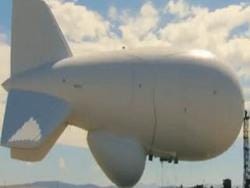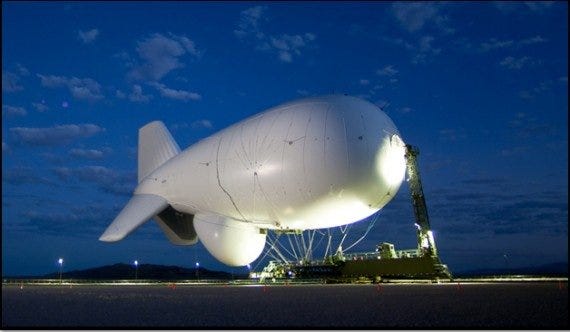Thanks to Joe the Taliban now have a giant blimp loaded with one of the world’s most advanced radar systems.
Last week the Taliban Interior Ministry in Kabul announced that they had arrested a man in Afghanistan who was in the process of selling something called the Joint Land Attack Cruise Missile Defense Elevated Netted Sensor System (JLENS) to Iran. Apparently, the Taliban wanted the JLENS for themselves so they seized the system and locked up the seller.
JLENS is an aerostat carrying a very sophisticated radar system. It is used to detect missiles, drones, aircraft, boats, and ground vehicles. The JLENS surveillance radar scans in all directions and can provide constant, 360-degree coverage extending over 300 miles.
During tests conducted by its manufacturer, Raytheon, the JLENS MTS-B electro-optical/infrared (EO/IR) sensor tracked numerous targets with its infrared (IR) sensor. Video from the MTS-B was passed through the aerostat's tether, enabling operators to watch a live feed of trucks, trains, and cars from dozens of miles away. While the MTS-B visually tracked targets, the JLENS simultaneously tracked the surface targets with its integrated radar system.
"The JLENS integrated fire-control radar and 360-degree surveillance radar already gives the warfighter the capability to detect and engage surface and airborne threats like swarming boats and anti-ship cruise missiles," said Dave Gulla, vice president of Global Integrated Sensors for Raytheon's Integrated Defense Systems business at the time. "Integrating the proven MTS-B on JLENS makes JLENS multi-mission capable and enables the warfighter to better defend the battlespace and protect critical infrastructure and waterways."


The aerostat flies as high as 10,000 feet and can remain aloft and operational for up to 30 days. They are intended to be used in pairs, with one carrying a 360-degree surveillance radar and the other a fire control radar. JLENS detects targets and then provides the information acquired to missile and gun systems, so the target can be destroyed.
There has been some controversy in recent years about the long-term utility of JLENS following an incident in which one of the aerostats broke loose from its tether and drifted from Maryland into Pennsylvania. Nonetheless, there has been general consensus that the radar system and other sensors are extremely capable and should be retained. In particular, the capacity of the systems to detect incoming cruise missiles, flying at low altitudes is exceptional.
Raytheon’s own literature describes the MTS system used on the JLENS as follows:
“Raytheon Intelligence & Space's Multi-Spectral Targeting System (MTS) combines electro-optical/ infrared (EO/IR), laser designation, and laser illumination capabilities in a single sensor package.
Combat proven, with nearly four million operational flight hours, the MTS product family of sensors, including MTS-A, MTS-B, MTS-C, MTS-D (AN/DAS-4) provide detailed intelligence data from the visual and infrared spectrum in support of U.S. military, civilian and allied missions around the world.
Using cutting-edge digital architecture, MTS brings long-range surveillance, target acquisition, tracking, range finding and laser designation for the Griffin® missile and Paveway® laser-guided bomb, as well as all tri-service and NATO laser-guided munitions. MTS sensors feature multiple fields of view, electronic zoom, multimode video tracking and are designed to incorporate future growth options and performance enhancements.
To date, Raytheon Intelligence & Space has delivered more than 3,000 MTS sensors to U.S. and international armed forces and successfully integrated 44 variants of the system on more than 20 rotary-wing, Unmanned Aerial System, and fixed-wing platforms – including the MH-60 Blackhawk, the C-130 Hercules, the MQ-9C Reaper, the MQ-1 Predator, and the MQ-1C Gray Eagle.”
Each JLENS aerostat costs almost $200 million. The program overall costs billions.
We developed the JLENS because the United States did not have a reliable capability to detect low flying threats like cruise missiles. Our other systems were not sufficiently advanced or capable. What the systems on the aerostat in the JLENS program gave us were capabilities no one else on the planet possessed.
We have largely backed away from the idea of using large numbers of JLENS aerostats, because of the issues associated with having the vehicles tethered and keeping them from getting away. All of the systems carried by the aerostats remain in use on other aircraft however and represent some of the most advanced technology we have. That technology is now in the possession of the Taliban.
Precisely why the Taliban intervened to stop the pending sale of JLENS to the Iranians remains unclear. Presumably, they either want the system for themselves or they intend to sell it to the highest bidder and pocket the cash. What is clear though is that we will exercise no control of any kind over what happens. The system may be used by the Taliban to detect future “over the horizon” attacks by the U.S. military. It may be sold to Communist China, reverse engineered, and mass-produced.
Whatever happens, we will be on the outside looking in. Thanks to Biden the Taliban now have one of the most sophisticated radar systems on Earth.






You'll never convince me that leaving this behind - intact - as was also done with so much other equipment (including high-tech) - was not done on purpose.
Same with the digital files with biometrics ID'ing everyone in Afghanistan who worked with us.
None dare say treason.